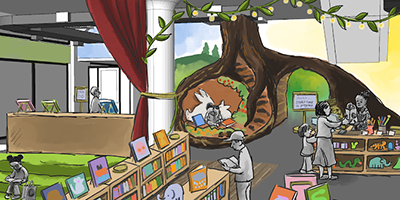Client Spotlight
The Rabbit Hole brings children’s literature to life with future-focused financing from Country Club Bank
 Designing and building an immersive children's literature museum like The Rabbit Hole – especially one of the first of its kind – is a massive and multifaceted undertaking requiring vision, financial acumen, and community engagement.
Designing and building an immersive children's literature museum like The Rabbit Hole – especially one of the first of its kind – is a massive and multifaceted undertaking requiring vision, financial acumen, and community engagement.
Like writing a book, it can take a while to get started, but the story can unfold quickly when you have a vision that resonates and community partners willing to listen, imagine, and invest.
Pete Cowdin and his wife, Deb Pettid, have been living this story for the past eight years as they’ve worked to bring The Rabbit Hole to life. Cowdin, a gifted storyteller himself, simplifies the origin story for brevity and clarity:
“We had a children’s bookstore for a long time (The Reading Reptile for nearly 30 years), we loved it, but we also thought a lot about how we could engage kids with books outside of the retail space, and that was the beginning of our concept for The Rabbit Hole.”
Cowdin and Pettid were also motivated to preserve the historical significance and rich culture of older children’s literature lost and forgotten in the modern publishing business model.
“For publishers, it's all about new books and top-sellers now, and people don’t even get to see most of the great literature for kids because they don’t promote their backlists,” said Cowdin.
Open since March 2024, The Rabbit Hole is enjoying rave reviews, national press coverage, and attendance figures well ahead of projections. While Cowdin knew they had a vision for something special, it wasn’t always clear how it would happen until a few key supporters emerged.
“The connections we made through the bookstore over the years helped a lot, including our connection with John and Marnie Sherman, whose kids grew up in our store,” said Cowdin. “The Shermans understood what we were doing and wanted to help immediately.”
Best known as the majority owners of the Kansas City Royals, the Shermans contributed strategic ideas and connections in addition to an initial investment to fund development. Other board members signed on, and the next big step was to choose a building to house the new museum.
Around the same time, Cowdin connected with Joe Close, President of Country Club Bank.
“We knocked on about 12 or 15 doors with little success, and then we met Joe Close,” Cowdin said. “He got what we wanted to do, took it back to Country Club, and they provided the loan to buy the building we’re in today.”
Cowdin said the Bank signed on as a partner because it could see more than a real estate loan.
“They saw that there was nothing quite like it in Kansas City or anywhere for that matter, and it was filling a gap and could be something special for the Kansas City area,” Cowdin said. “Their understanding of the community and the market enabled them to imagine the possibilities and make the only fair loan offer we received.”
Cowdin said attendance and revenues at The Rabbit Hole are well ahead of schedule, with over 150,000 visitors expected to pass through the museum in its first year. Plans have also already begun for new and rotating exhibits to keep visitors coming back regularly. Cowdin is equally gratified and amazed by the journey.
“The Bank was fundamental to our ability to move the project forward, and it was kind of miraculous thinking about this,” said Cowdin. “You just get lucky sometimes, and we were lucky enough to find Country Club Bank.”